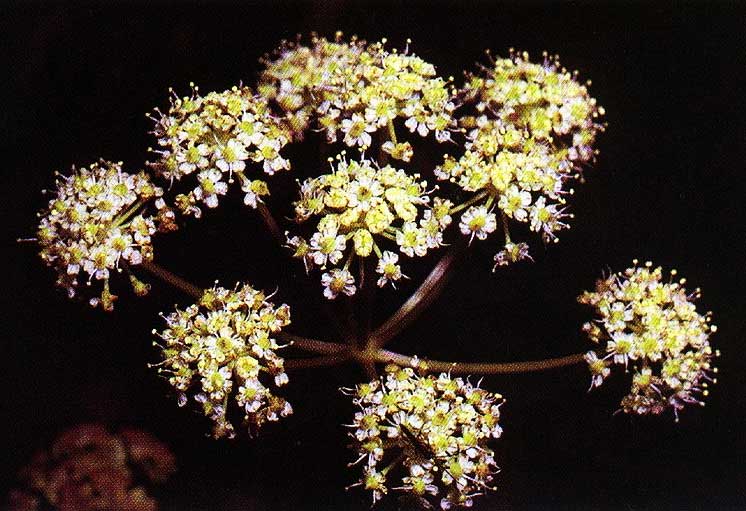
Cicuta douglasii (Robert H. Mohlenbrock @ USDA-NRCS PLANTS Database)
Classification System: APG IV
Superregnum: Eukaryota
Regnum: Plantae
Cladus: Angiosperms
Cladus: Eudicots
Cladus: Core eudicots
Cladus: Asterids
Cladus: Campanulids
Ordo: Apiales
Familia: Apiaceae
Subfamilia: Apioideae
Tribus: Oenantheae
Genus: Cicuta
Species: Cicuta douglasii
Name
Cicuta douglasii (DC.) J.M.Coult. & Rose
Synonyms
Cicuta californica A. Gray
Cicuta frondosa Greene
Cicuta maculata Hook. & Arn.
Cicuta maculata var. californica (A.Gray) B.Boivin
Cicuta mexicana J.M.Coult. & Rose
Cicuta occidentalis f. frondosa Greene
Sium douglasii DC.
Distribution
Native distribution areas:
Continental: Northern America
Alaska, USA (California, Idaho, Montana, Nevada, Oregon, Washington State), Canada (British Columbia, Northern Territories), Mexico (Chihuahua)
References: Brummitt, R.K. 2001. TDWG – World Geographical Scheme for Recording Plant Distributions, 2nd Edition
References
Coulter, J.M. & Rose, J.N., Contributions from the United States National Herbarium. Smithsonian Institution 7:95. 1900
Links
Hassler, M. 2018. Cicuta douglasii. World Plants: Synonymic Checklists of the Vascular Plants of the World In: Roskovh, Y., Abucay, L., Orrell, T., Nicolson, D., Bailly, N., Kirk, P., Bourgoin, T., DeWalt, R.E., Decock, W., De Wever, A., Nieukerken, E. van, Zarucchi, J. & Penev, L., eds. 2018. Species 2000 & ITIS Catalogue of Life. Published on the internet. Accessed: 2018 Aug. 23. Reference page.
International Plant Names Index. 2018. Cicuta douglasii. Published online. Accessed: Aug. 23 2018.
The Plant List 2013. Cicuta douglasii in The Plant List Version 1.1. Published on the internet. Accessed: 2018 Aug. 23.
Tropicos.org 2018. Cicuta douglasii. Missouri Botanical Garden. Published on the internet. Accessed: 2018 Aug. 23.
USDA, ARS, Germplasm Resources Information Network. Cicuta douglasii in the Germplasm Resources Information Network (GRIN), U.S. Department of Agriculture Agricultural Research Service. Accessed: 07-Oct-06.
Vernacular names
English: Western Water Hemlock
Cicuta douglasii, the western water hemlock, is a poisonous plant in the family Apiaceae. It is a perennial plant that grows in wet places such as marshes, stream banks, slough margins, ditches, meadows, and wet pastures.[1][2] The roots are thick and tuberous, with many smaller tubers on the main tuber,[3] allowing survival in wet conditions. Water hemlock is most abundant in British Columbia,[1] and is indigenous to North America,[3] where it grows primarily from the base of the Rocky Mountains to the Pacific coast, stretching from Alaska all the way to California. Water requirements limit this plant from inhabiting open rangelands.[3]
Characteristics of water hemlock include its stem, which is 0.5–2 meters tall with purplish spots, thick roots, and alternate leaves that are compound pinnate.[2] The leaflets are usually 5–8 cm long and 1–2 cm wide, with jagged edges.[3] Its inflorescences are compound umbellate with many small, white flowers.[3] There are two seeds per flower. Seed dispersal is by means of wind, water, machinery, clothing, and through transported soil.[1] The seeds germinate in spring, and flowers mature near the end of June and beginning of July.[3] In addition to sprouting new plants from seeds, rootstocks can also produce new plants in the fall from the basal meristem. When these detach the following spring, they may form a new plant.
Toxicity
Main article: Cicuta toxicity
The main distinguishing characteristic of western water hemlock is its toxicity. Cicutoxin is the toxin that is produced, making water hemlock the most poisonous plant in North America.[4] Cicutoxin is a yellowish liquid that is prevalent in the roots. This unsaturated alcohol has a major impact on the central nervous system of animals. Early symptoms of cicutoxin poisoning include excessive salivation, frothing at the mouth, nervousness, and incoordination. These symptoms can progress to tremors, muscular weakness, seizures and respiratory failure.[3] Ingestion of green materials of western water hemlock in amounts equivalent to about 0.1% of a person's body weight can even lead to death.[5] In addition to being extremely hazardous to humans, this plant has an enormous impact on animals. As little as 0.2–0.5% body weight for sheep, 0.1% body weight for cattle, 0.5% body weight for horses, and 0.3% body weight for swine can be lethal. Death can occur within fifteen minutes of ingesting the toxin. It is one of the first plants to emerge in springtime, and has a very appealing odor.[3] These characteristics, along with the fact that it grows in moist areas, make the plant very attractive, but deadly, to grazing animals.
References
Weeds BC (2005-07-13). "Water hemlock, Cicuta douglasii". Archived from the original on 2002-07-30.
Saskatchewan Agriculture and food (2005-07-13). "Western water hemlock". Archived from the original on 2005-10-28.
Block, N. (n.d.). (2005-07-13). "Cicuta douglasii (DC.) Coult. & Rose".
Schep LJ, Slaughter RJ, Becket G, Beasley DM (April 2009). "Poisoning due to water hemlock". Clin Toxicol. 47 (4): 270–8. doi:10.1080/15563650902904332. PMID 19514873. S2CID 21855822.
Ministry of agriculture, food & fisheries (2005-07-13). "Western water hemlock". Archived from the original on 2005-08-29.
Retrieved from "http://en.wikipedia.org/"
All text is available under the terms of the GNU Free Documentation License

